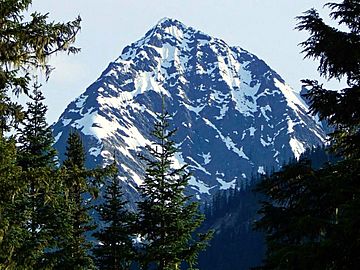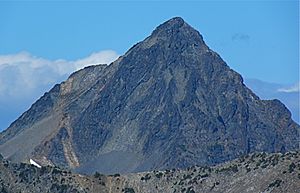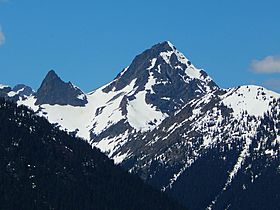Graybeard Peak facts for kids
Quick facts for kids Graybeard Peak |
|
|---|---|

Graybeard Peak
|
|
| Highest point | |
| Elevation | 7,965 ft (2,428 m) |
| Prominence | 1,005 ft (310 m) |
| Geography | |
| Parent range | Cascade Range |
| Topo map | USGS Mount Arriva |
| Climbing | |
| First ascent | 1959 by Carl Ben Casey, William Long |
| Easiest route | Scramble |
Graybeard Peak is a tall mountain in Skagit County, Washington. It stands about 7,965 feet (2,428 meters) high. This peak is part of the amazing North Cascades mountain range.
You can see Graybeard Peak from the North Cascades Highway. It's especially visible from the Easy Pass Trailhead. The mountain sits right on the edge of North Cascades National Park.
Graybeard Peak is part of a group of mountains called Ragged Ridge. Some other peaks nearby are Mesahchie Peak, Kimtah Peak, and Katsuk Peak. The closest taller mountain is Fisher Peak, which is about 1.33 miles (2.14 km) to the south. Water from the east side of Graybeard Peak flows into Ross Lake. Water from the west side goes into Diablo Lake.
Mountain Weather: Climate at Graybeard Peak
Graybeard Peak has a special kind of weather called a marine west coast climate. This means it gets a lot of moisture from the Pacific Ocean. Most of the weather systems start over the Pacific. They then travel northeast towards the Cascade Mountains.
When these weather systems hit the tall Cascade Mountains, they are forced to rise. This makes them drop their moisture as rain or snow. So, the western side of the North Cascades gets a lot of rain and snow, especially in winter.
Because it's close to the ocean, the temperatures here are usually mild. It rarely gets colder than 0°F (-18°C) or hotter than 80°F (27°C). Winters are often cloudy, but summers are usually clear and sunny. The snow here tends to be wet and heavy. This can sometimes lead to a high risk of avalanches.
How Mountains Formed: Geology of the North Cascades
The North Cascades mountains are known for their rugged and dramatic look. They have sharp peaks, long ridges, and deep valleys carved by glaciers. The amazing shapes of these mountains were created by geological events that happened millions of years ago. These events also led to big changes in elevation. This created different climates and types of plants in the area.
The Cascade Mountains started forming millions of years ago, during the late Eocene Epoch. At that time, the North American Plate was slowly moving over the Pacific Plate. This caused many volcanic eruptions. Also, small pieces of the Earth's crust, called terranes, came together. This helped create the North Cascades about 50 million years ago.
Later, during the Pleistocene period (over two million years ago), huge sheets of ice called glaciers moved across the land. They advanced and retreated many times. As they moved, they scraped away rock and left behind debris. The "U"-shaped valleys you see in the rivers today were carved out by these glaciers. The combination of land being pushed up (called uplift) and cracks in the Earth's crust (called faulting), along with glaciation, formed the tall peaks and deep valleys of the North Cascades.





